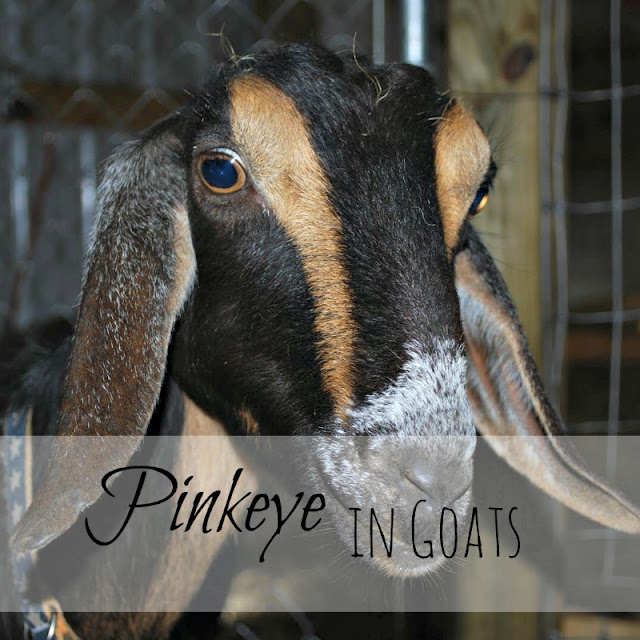How to recognize pink-eye in goats
One hot summer morning when I went outside to feed the goats, Wish, the herd queen, didn't come to the gate to greet me with the rest of the herd.
She stood in the deep shade of the goat shed and bawled at me. That's not normal goat behavior.
As I walked toward her she acted as though she were blind, not focusing on anything in particular and not watching me approach her.
How could she have gone blind overnight, I wondered?
Her eyes were clouded over and she refused to leave the shed, as though the light hurt her eyes. I realized it must be pink eye and that she had the bacterial infection in both eyes.
What is pink eye?
Pink eye (bacterial conjunctivitis) is an infection or inflammation of the outer membrane of the eyeball and the inner eyelid.
It's highly contagious and can be spread throughout a herd by flies, so it's often a summer problem when flies are at their worst.
If left untreated, pink eye will run its course and go away on its own eventually; it's a "self-limiting condition."
But Wish's eyes definitely bothered her and I certainly didn't want it to spread through my herd.
By the way, I've had pink eye myself - twice in the past few years - and it is irritating, itchy and definitely uncomfortable. I would hate for someone to decide that my own case should "run its course." I desperately wanted some relief.
How to treat pink eye in goats
Disclaimer: I am not a veterinarian. You are responsible for your animals' health. This is what I chose to use on my own livestock. Please do your own research before using any products, plants, herbs, and/or essential oils.
Pink eye can be treated with antibiotics, but I avoid using them unless it's absolutely necessary because antibiotics kill both the bad and good bacteria in our bodies (including goat bodies).
Humans and livestock can also become resistant to antibiotics if we take them often.
Antibiotics can be lifesaving, and I will give them if it's a serious infection and if my veterinarian says it's needed, but in this case, I preferred to treat Wish's case of pink eye without them.
Although we aren't raising our goats to be food animals, we do drink goat milk.
Since antibiotic residue can be present in an animal's milk, it's standard practice to discard milk from a dairy animal receiving antibiotics for quite some time after use.
For all of these reasons, I don't administer antibiotics unless it's necessary. I try to raise goats as naturally as possible.
Treatment plan
After researching ways to treat pink eye in humans, I formed a treatment plan for Wish.
I treated Wish twice a day, first using a warm washcloth to soothe her eyes and to loosen the dried mucus and debris in the lashes, then gently washed her eyelids with baby shampoo (the no-tears brand).
I was careful to wash from the inner corner to the outside corner of her eye, to avoid getting bacteria and dirt in the tear ducts.
Then I washed the shampoo from her eyes with a second warm washcloth.
My barn doesn't have plumbing, so the best way to have a "clean, warm washcloth" is to fill a jar with hot water in the house, add the two washcloths, and put a lid on the jar.
When I get out to the barn, I remove a washcloth as needed and wring the water out of it. Used washcloths are put in a different container to carry back to the house. Avoiding contamination is important!
Next I gave Wish a dose of fermented cod liver oil using a needle-less syringe. Part of the dose was squirted into each eye and the rest was squirted into the back of her mouth.
People with vitamin A deficiencies might be more susceptible to getting pink eye - perhaps this is true for goats too - and cod liver oil is one of the treatments for this deficiency. [Source]
Finally I used a cotton ball to cleanse the goat's face gently with mouthwash, the green brand. I was very careful to not get the mouthwash in her eyes, and I used a new cotton ball for each side of her face.
Wish loved this part of her treatment!
I don't know if she liked the minty-fresh smell or if the mouthwash was cooling and fresh-feeling on her skin, but she was very willing to stand still until the liquid dried.
Perhaps using another cotton ball with baby shampoo and water would have been sufficient, but I used mouthwash.
This last step - cleansing the goat's face - is important.
Pink eye causes the eyes to tear and drain. Flies are attracted to this drainage, and when they land on the goat's face they can then carry the bacteria from one goat to another, spreading the infection throughout the herd.
Keeping the goat comfortable
Since the sun hurt Wish's eyes and she preferred to stay inside the shed, I made sure she had water and hay inside.
After just a few days Wish's eyes cleared up and she was back outside with the herd - and thankfully it didn't spread to any of my other goats.
Related Posts:
Livestock First Aid Kit
Building the Goat Barn
What you need to know about raising goats
As a goat lover and a homestead gardener, I'm excited to also share my gardening tips with you - from planting seeds to enjoying the fruits (and vegetables) of your labor! You can find my gardening advice and insights right here, so let's dig in and cultivate some fresh, delicious produce together.














